Design for Additive Manufacturing: Transforming RF antennas through intelligent optimisation
Additive Manufacturing presents the opportunity to completely rethink a product’s design, transforming its functionality and reducing manufacturing complexity. With the right application and the right approach, the results really can live up to industry buzzwords such as ‘disruptive’ and ‘transformational’. In the following article, Optisys LLC reveals how, through intelligent design optimisation, the company has used Additive Manufacturing to develop the next generation of RF antenna systems for aerospace and defence. [First published in Metal AM Vol. 3 No. 3, Autumn 2017 | 10 minute read | View on Issuu | Download PDF]

Optisys, based in West Jordan, Utah, USA, is a specialist producer of innovative radio frequency (RF) antenna systems using Additive Manufacturing. By applying the principles of Design for Additive Manufacturing (DfAM), the company’s engineering team can take an antenna assembly that has a hundred parts and consolidate them into just one. Optisys’ CEO Clinton Cathey calls the results of this extreme parts consolidation ‘single-piece assemblies.’ The result is a dramatic reduction in size, weight, lead time and cost while boosting RF performance. Fig. 1 shows an aircraft antenna with an AM antenna feed running horizontally through its centre and an AM Ortho Mode Transducer protruding through the rear; these two components were optimised through DfAM.
“There are not many companies like us that are designing products to take full advantage of AM,” stated Cathey. “Designing antennas for Additive Manufacturing requires a new way of thinking about structures. The early adopters of AM made just prototypes and tooling and that mindset is still pretty widespread. But we formed our company by identifying a niche market where Additive Manufacturing is the production method from the start. We’re solving end-use challenges with it.”
Earlier this year Optisys revealed the savings possible in weight, time and costs through parts consolidation in a Ka-band monopulse tracking array. Today the company is developing a full line of customisable antenna feeds and other antenna products and delivered its first commercial products to a customer this summer (Fig. 2).
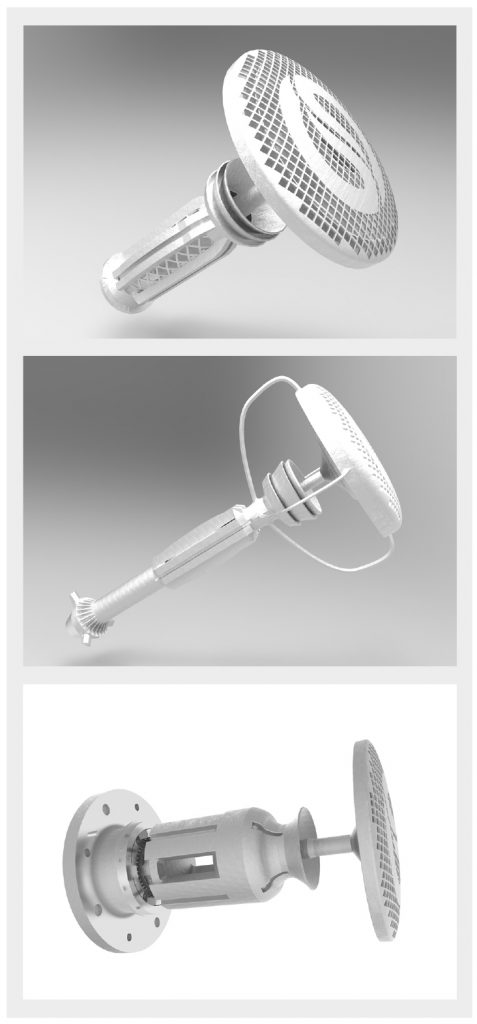
An opportunity to fill an industry void
Cathey and COO Rob Smith came together to form Optisys with a like-minded group of colleagues who share a combined sixty years’ experience in the aerospace systems world which includes RF design, satellite communications (SATCOM), mechanical engineering and Additive Manufacturing.
“We had the total package for generating full antenna systems and, with our experience in AM, we saw the potential to put everything together to fill a void in this niche market,” states Smith. The team felt that the AM industry as a whole had a weakness in terms of value-added engineering. “We realised we could be the turnkey provider that adds pre- and post-processing to meet exact customer specifications,” Smith explained.
Cathey agreed, stating, “There are certainly plenty of companies that know how to do design, that know how to additively manufacture, but there’s a lot of throwing things over the wall between them. You end up with parts that are intended to be machined, or designed for traditional manufacturing methods, that don’t take full advantage of Additive Manufacturing.”
The ability to consolidate parts with AM was what sparked the idea to form Optisys, stated Smith. “We had a high degree of intuition that Additive Manufacturing would solve many of the problems we’d been fighting in our past experiences with antenna manufacturing” (Fig. 3).
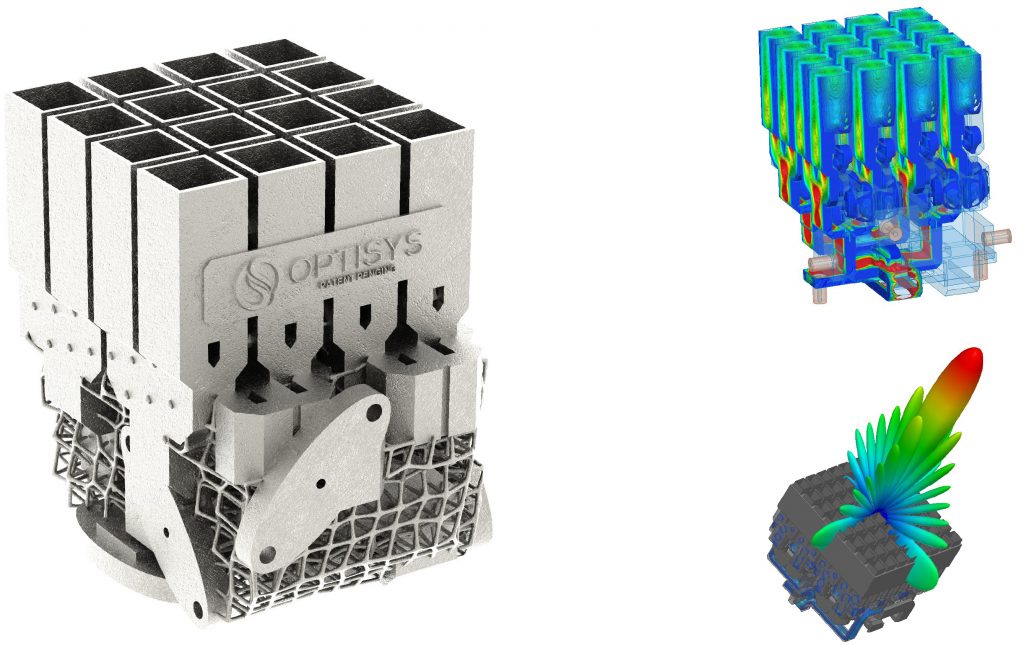
AM overcomes the challenges of conventional production
The challenges faced by an antenna producer when using conventional manufacturing technologies are numerous, adding both time and money. There is often a huge number of parts in a conventional design, typically a daunting array of a hundred or more individual metal components (Fig. 4). These include the hollow, rectangular waveguides so critical for channelling the electromagnetic energy carrying the data; these are joined together via brazing, plunge EDM and/or multiple bolted joints.
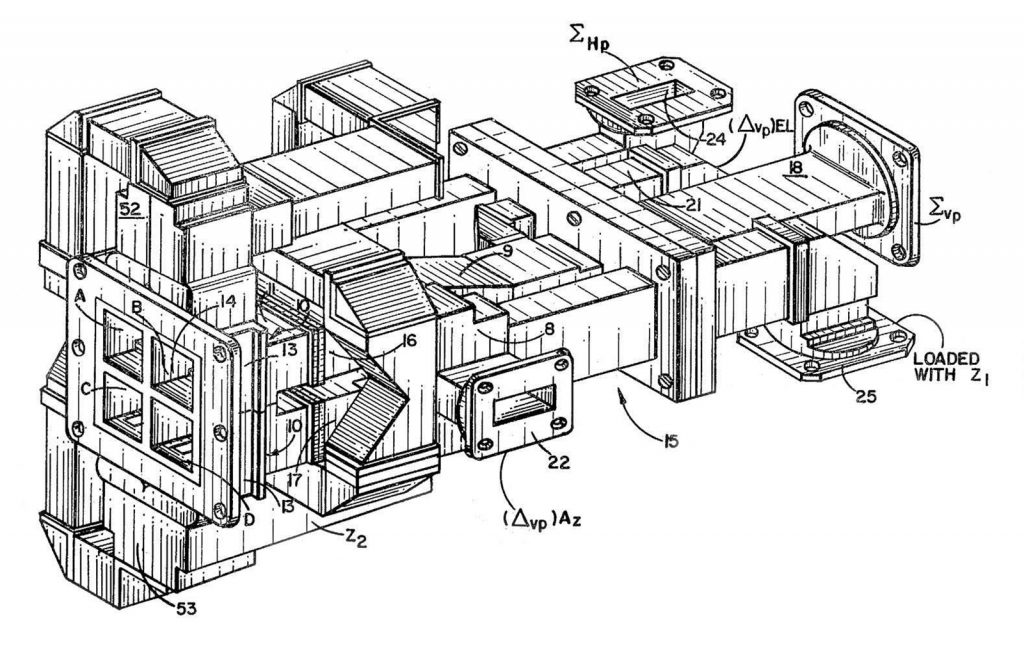
Such assemblies can be large and long with unique shapes creating internal geometric hazards that can interfere with the flow of the very data the antenna is supposed to convey. “Every single joint, seam or fastener creates the potential for a discontinuity that can result in RF losses as the signal travels through the antenna,” stated Smith. “Even how tight you make the screws can add a lot of variability to this insertion loss – if you don’t do it exactly right you can end up with an inadvertent antenna at each of your seams.”
Tolerances can also be an issue when a hundred or more parts are joined together, Smith pointed out. “When you have the kind of complicated system you get with a traditionally manufactured antenna assembly, you have to inspect each piece part independently, then put them all together and hope it translates to better overall RF performance. The tolerances of each part have to be very, very exact and by the time you integrate so many pieces together you can have significant tolerance stack-up and be completely off target.”
Additive Manufacturing, by contrast, supported the type of systems-engineering approach that Optisys’ founders envisioned for building their business. By viewing an antenna assembly as an integrated structure in which all the parts are combined into a single functional one, they realised they would be able to reduce lead times from months to weeks, cut size and weight dramatically and improve costs to their customers.
“Of course, we did testing to validate our assumptions and took parts to customers to get their responses and then tested for answers to their questions. But we had already done enough internal testing to convince ourselves that we were onto something,” stated Cathey.
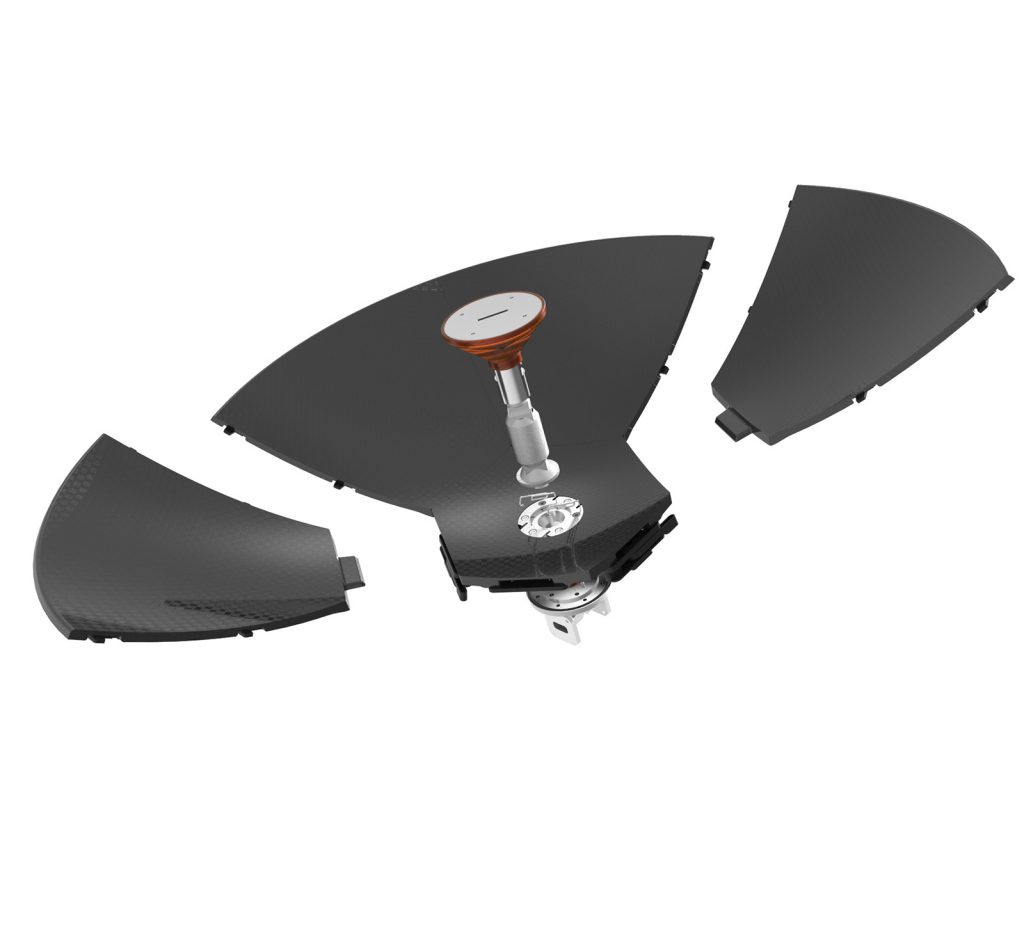
The biggest discovery during early evaluations, and the one that delivered the most convincing value proposition to potential customers, was that the smaller size of their additively manufactured products greatly shortened the overall distance that an RF signal had to travel within the system, a huge benefit to antenna performance.
Extreme accuracy is not necessary for, say, a car antenna, which picks up signals from 360° around the vehicle. But the directional, microwave antennae used for most satellite and line-of-sight communications, aircraft and UAVs operate in the 1-100 GHz frequency band. In those industries, light weight is highly desirable.
“We found a sweet spot for Additive Manufacturing where the technology provides many benefits and is also economically advantageous,” stated Cathey. “With our Ka-band monopulse tracking array we tested RF frequencies to 30 GHz, which is much higher than anyone else was doing; other companies have only reached 5-15 GHz.” As with all Optisys products, the Ka-band array was evaluated for both bench and outdoor RF range performance. Similar designs have passed rigorous vibration testing for ‘military ruggedness.’ Subsequent Optisys designs have reached up to 50 GHz in RF capacity.
Designing for AM
The Concept Laser metal AM machine used by Optisys provides the build quality to achieve such results, Smith stated. “I’ve been very happy with its fine resolution, nice surface finish and the superior ‘human factor’ element of working with these machines. We felt confident that we can meet the type of feature resolutions that we need with them.”
Aluminium is the material of preference for a build; it stands up better than plastics to environmental stresses, from ground level to outer space, and has essentially the same properties as a solid piece of the same material.
It could be said that the final AM process is the easiest stage of Optisys’ systems-engineering approach to antenna production; however, the company stresses that it is critical to design for AM from the start. “This lets us take advantage of all the best aspects of Additive Manufacturing, while recognising its challenges and designing around those,” stated Smith.
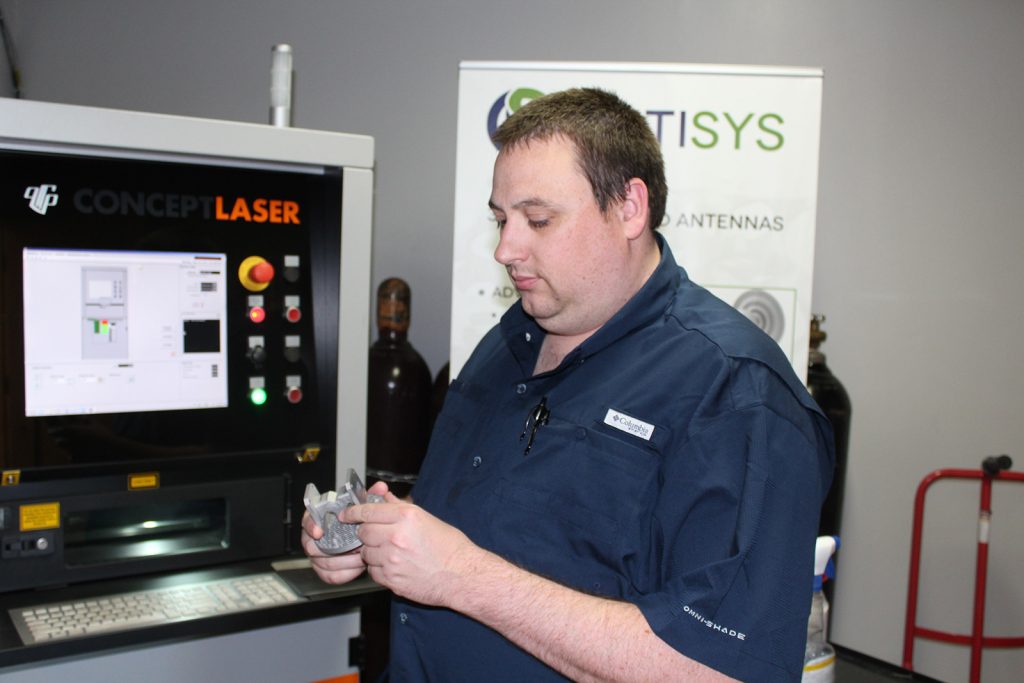
Rather than start from a pre-conceived geometry, Optisys begins with the RF requirements desired for the finished product. “Because AM promotes parts consolidation, we have the freedom to work towards the goal of optimum RF output rather than derived requirements such as individual part tolerances,” explained Smith. “Your typical Additive Manufacturing service bureau doesn’t have the RF expertise to achieve these requirements, so passing inspection is a challenge because the critical geometry is internal and can’t be measured directly. Using AM, we can avoid internal geometry issues and deliver the lowest insertion loss and the highest RF possible for each design.”
For the next step in Optisys’ process the group’s RF expert, Mike Hollenbeck, develops a microwave simulation using Ansys HFSS software to model the high-frequency electromagnetic field inside the air cavity of the proposed array. Smith explained, “Mike and I go back and forth a bit to identify the air-cavity design that best meets our requirements, then I import that file into SolidWorks to figure out the optimum wall thickness for the aluminium walls that I’ll ‘wrap around’ that air cavity in order to create a design that can be additively manufactured as a single metal assembly.”
At this point Smith uses his experience and intuition to create the ideal topology of the design, adding just enough extra material where needed to create an integrated unit which will manufacture consistently. He also adds support structures for those features that merit them, using Autodesk Within and merging the result using SolidWorks and Magics. “These integrated support structures stabilise the geometry throughout the build, drawing the heat away so we don’t get stress concentrations in shrinkage locations, and then provide the entire system with support when it’s in operation,” stated Smith. “They also happen to look pretty cool!”
Benefits beyond the build
The final design is transferred into Concept Laser’s proprietary manufacturing software, which drives what Concept Laser calls the LaserCUSING® process in the AM machine. The advantages of Additive Manufacturing carry forward, Smith pointed out. “By consolidating parts, you’ve already designed out assembly and rework. You can easily tweak an existing design with new features, and components with fewer parts require less maintenance and service over time.”
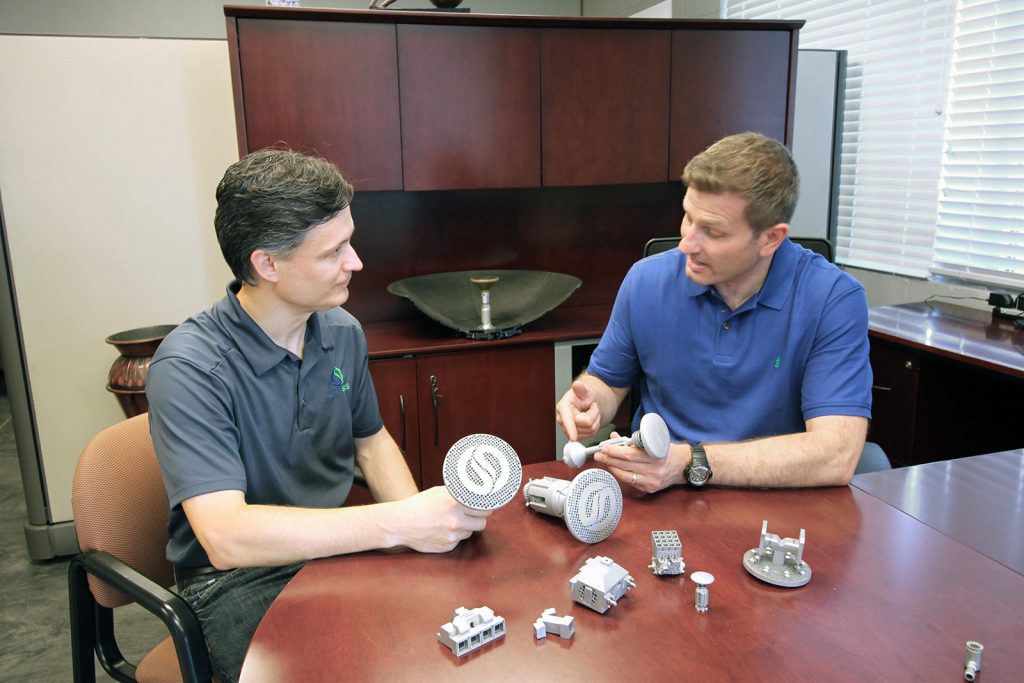
With a number of patents pending and discussions progressing with leading aerospace companies and academic institutions about expanding their portfolio of antenna-product lines, Optisys is optimistic about business growth. “Our competitive advantage is the integration of systems engineering, design and Additive Manufacturing, all customised for this niche application,” stated Cathey. “We haven’t even pushed the RF boundaries as far as they can go yet so metal Additive Manufacturing will continue to be pivotal in getting us there.”
Cathey has some advice for others looking to capitalise on AM technology; “I highly encourage people to look closely at Additive Manufacturing and find other niche markets in which to apply it from the very beginning. There’s still a lot to be achieved there.”
Contact
Optisys LLC
6764 Airport Rd
West Jordan, UT 84084
USA
Tel: +1 801 664 5595
Email: [email protected]
www.optisys.tech







